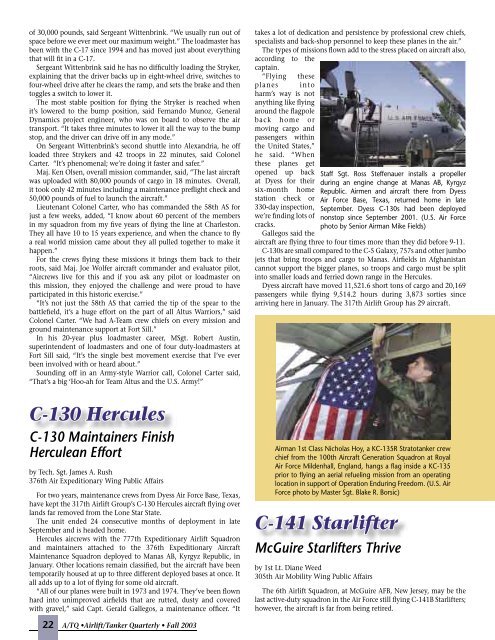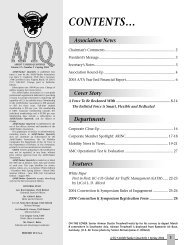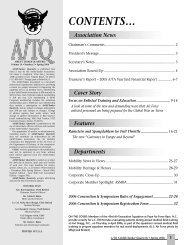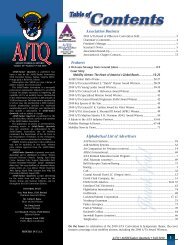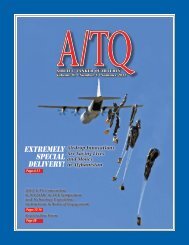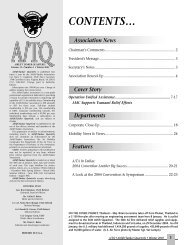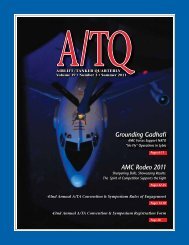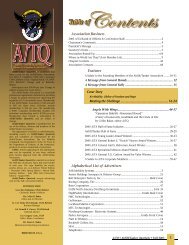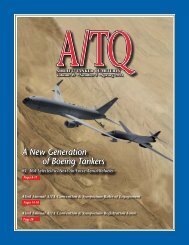1) ATQ Fall 2003 for pdf - Airlift/Tanker Association
1) ATQ Fall 2003 for pdf - Airlift/Tanker Association
1) ATQ Fall 2003 for pdf - Airlift/Tanker Association
Create successful ePaper yourself
Turn your PDF publications into a flip-book with our unique Google optimized e-Paper software.
of 30,000 pounds, said Sergeant Wittenbrink. “We usually run out of<br />
space be<strong>for</strong>e we ever meet our maximum weight.” The loadmaster has<br />
been with the C-17 since 1994 and has moved just about everything<br />
that will fit in a C-17.<br />
Sergeant Wittenbrink said he has no difficultly loading the Stryker,<br />
explaining that the driver backs up in eight-wheel drive, switches to<br />
four-wheel drive after he clears the ramp, and sets the brake and then<br />
toggles a switch to lower it.<br />
The most stable position <strong>for</strong> flying the Stryker is reached when<br />
it’s lowered to the bump position, said Fernando Munoz, General<br />
Dynamics project engineer, who was on board to observe the air<br />
transport. “It takes three minutes to lower it all the way to the bump<br />
stop, and the driver can drive off in any mode.”<br />
On Sergeant Wittenbrink’s second shuttle into Alexandria, he off<br />
loaded three Strykers and 42 troops in 22 minutes, said Colonel<br />
Carter. “It’s phenomenal; we’re doing it faster and safer.”<br />
Maj. Ken Olsen, overall mission commander, said, “The last aircraft<br />
was uploaded with 80,000 pounds of cargo in 18 minutes. Overall,<br />
it took only 42 minutes including a maintenance preflight check and<br />
50,000 pounds of fuel to launch the aircraft.”<br />
Lieutenant Colonel Carter, who has commanded the 58th AS <strong>for</strong><br />
just a few weeks, added, “I know about 60 percent of the members<br />
in my squadron from my five years of flying the line at Charleston.<br />
They all have 10 to 15 years experience, and when the chance to fly<br />
a real world mission came about they all pulled together to make it<br />
happen.”<br />
For the crews flying these missions it brings them back to their<br />
roots, said Maj. Joe Wolfer aircraft commander and evaluator pilot,<br />
“Aircrews live <strong>for</strong> this and if you ask any pilot or loadmaster on<br />
this mission, they enjoyed the challenge and were proud to have<br />
participated in this historic exercise.”<br />
“It’s not just the 58th AS that carried the tip of the spear to the<br />
battlefield, it’s a huge ef<strong>for</strong>t on the part of all Altus Warriors,” said<br />
Colonel Carter. “We had A-Team crew chiefs on every mission and<br />
ground maintenance support at Fort Sill.”<br />
In his 20-year plus loadmaster career, MSgt. Robert Austin,<br />
superintendent of loadmasters and one of four duty-loadmasters at<br />
Fort Sill said, “It’s the single best movement exercise that I’ve ever<br />
been involved with or heard about.”<br />
Sounding off in an Army-style Warrior call, Colonel Carter said,<br />
“That’s a big ‘Hoo-ah <strong>for</strong> Team Altus and the U.S. Army!”<br />
takes a lot of dedication and persistence by professional crew chiefs,<br />
specialists and back-shop personnel to keep these planes in the air.”<br />
The types of missions flown add to the stress placed on aircraft also,<br />
according to the<br />
captain.<br />
“Flying these<br />
planes into<br />
harm’s way is not<br />
anything like flying<br />
around the flagpole<br />
back home or<br />
moving cargo and<br />
passengers within<br />
the United States,”<br />
he said. “When<br />
these planes get<br />
opened up back<br />
at Dyess <strong>for</strong> their<br />
six-month home<br />
station check or<br />
330-day inspection,<br />
we’re finding lots of<br />
cracks.<br />
Gallegos said the<br />
Staff Sgt. Ross Steffenauer installs a propeller<br />
during an engine change at Manas AB, Kyrgyz<br />
Republic. Airmen and aircraft there from Dyess<br />
Air Force Base, Texas, returned home in late<br />
September. Dyess C-130s had been deployed<br />
nonstop since September 2001. (U.S. Air Force<br />
photo by Senior Airman Mike Fields)<br />
aircraft are flying three to four times more than they did be<strong>for</strong>e 9-11.<br />
C-130s are small compared to the C-5 Galaxy, 757s and other jumbo<br />
jets that bring troops and cargo to Manas. Airfields in Afghanistan<br />
cannot support the bigger planes, so troops and cargo must be split<br />
into smaller loads and ferried down range in the Hercules.<br />
Dyess aircraft have moved 11,521.6 short tons of cargo and 20,169<br />
passengers while flying 9,514.2 hours during 3,873 sorties since<br />
arriving here in January. The 317th <strong>Airlift</strong> Group has 29 aircraft.<br />
C-130 Hercules<br />
C-130 Maintainers Finish<br />
Herculean Ef<strong>for</strong>t<br />
by Tech. Sgt. James A. Rush<br />
376th Air Expeditionary Wing Public Affairs<br />
For two years, maintenance crews from Dyess Air Force Base, Texas,<br />
have kept the 317th <strong>Airlift</strong> Group’s C-130 Hercules aircraft flying over<br />
lands far removed from the Lone Star State.<br />
The unit ended 24 consecutive months of deployment in late<br />
September and is headed home.<br />
Hercules aircrews with the 777th Expeditionary <strong>Airlift</strong> Squadron<br />
and maintainers attached to the 376th Expeditionary Aircraft<br />
Maintenance Squadron deployed to Manas AB, Kyrgyz Republic, in<br />
January. Other locations remain classified, but the aircraft have been<br />
temporarily housed at up to three different deployed bases at once. It<br />
all adds up to a lot of flying <strong>for</strong> some old aircraft.<br />
“All of our planes were built in 1973 and 1974. They’ve been flown<br />
hard into unimproved airfields that are rutted, dusty and covered<br />
with gravel,” said Capt. Gerald Gallegos, a maintenance officer. “It<br />
Airman 1st Class Nicholas Hoy, a KC-135R Stratotanker crew<br />
chief from the 100th Aircraft Generation Squadron at Royal<br />
Air Force Mildenhall, England, hangs a flag inside a KC-135<br />
prior to flying an aerial refueling mission from an operating<br />
location in support of Operation Enduring Freedom. (U.S. Air<br />
Force photo by Master Sgt. Blake R. Borsic)<br />
C-141 Starlifter<br />
McGuire Starlifters Thrive<br />
by 1st Lt. Diane Weed<br />
305th Air Mobility Wing Public Affairs<br />
The 6th <strong>Airlift</strong> Squadron, at McGuire AFB, New Jersey, may be the<br />
last active-duty squadron in the Air Force still flying C-141B Starlifters;<br />
however, the aircraft is far from being retired.<br />
22 A/TQ •<strong>Airlift</strong>/<strong>Tanker</strong> Quarterly • <strong>Fall</strong> <strong>2003</strong>


